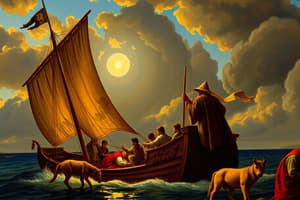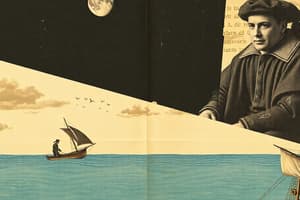Podcast
Questions and Answers
What were the primary indigenous groups interacted with during Pigafetta's expedition?
What were the primary indigenous groups interacted with during Pigafetta's expedition?
- Visayans and Cebuano (correct)
- Tagalogs and Ilocanos
- Filipinos and Malays
- Mactanese and Spaniards
What was one significant outcome of the voyage from 1519 to 1522?
What was one significant outcome of the voyage from 1519 to 1522?
- Declaration of war on Portugal
- Establishment of permanent colonies in the Americas
- Discovery of the trade route to India
- First circumnavigation of the Earth (correct)
What motivated the introduction of Christianity during the expedition?
What motivated the introduction of Christianity during the expedition?
- Desire to spread democracy
- Political alliances and conversions (correct)
- Secularization efforts of the Spanish crown
- Preference for local traditions
Who led the battle in Mactan against Magellan's forces?
Who led the battle in Mactan against Magellan's forces?
What does Antonio Pigafetta's journal contribute to our understanding?
What does Antonio Pigafetta's journal contribute to our understanding?
Which principle primarily drove the objectives of Magellan's expedition?
Which principle primarily drove the objectives of Magellan's expedition?
What resulted from the Battle in Mactan for Magellan?
What resulted from the Battle in Mactan for Magellan?
What led to the documentation of diverse languages and customs during the voyage?
What led to the documentation of diverse languages and customs during the voyage?
What was a key outcome of engaging in trade with indigenous populations during the voyage?
What was a key outcome of engaging in trade with indigenous populations during the voyage?
How did Pigafetta's crew attempt to overcome language barriers with indigenous peoples?
How did Pigafetta's crew attempt to overcome language barriers with indigenous peoples?
What significant resistance did the missionaries encounter during their efforts to spread Christianity?
What significant resistance did the missionaries encounter during their efforts to spread Christianity?
What was one of the prominent features of the ships used during the expedition?
What was one of the prominent features of the ships used during the expedition?
Which of the following claims about the ship Victoria is accurate?
Which of the following claims about the ship Victoria is accurate?
What specific incident led to the death of Magellan?
What specific incident led to the death of Magellan?
How did Pigafetta document the diverse cultures he encountered?
How did Pigafetta document the diverse cultures he encountered?
Which aspect of the expedition was closely linked to the broader European mission of the time?
Which aspect of the expedition was closely linked to the broader European mission of the time?
What logistical challenges did Pigafetta and the crew face during the voyage?
What logistical challenges did Pigafetta and the crew face during the voyage?
Flashcards are hidden until you start studying
Study Notes
Cultural Encounters
- Antonio Pigafetta documented encounters with various cultures during the voyage.
- The expedition interacted with indigenous peoples in the Philippines, notably the Visayans and the Cebuano.
- Descriptions included customs, clothing, languages, and social structures of different communities.
- Notable exchange of goods, such as spices and textiles, illustrating early globalization.
Historical Significance
- The voyage (1519-1522) marked the first circumnavigation of the Earth.
- Provided crucial information about geography and diverse cultures.
- Highlighted the capabilities of maritime navigation and the importance of exploration.
- Contributed to the understanding of the Pacific Ocean and its islands.
Biography of Antonio Pigafetta
- Born in 1491 in Vicenza, Italy; died around 1531.
- Served as a navigator and chronicler for the expedition led by Ferdinand Magellan.
- His detailed journal provided one of the first comprehensive accounts of the global voyage.
- Contributed to the knowledge of geography, ethnography, and navigation through his writings.
Battle in Mactan
- Took place on April 27, 1521, between Spanish forces led by Magellan and native warriors led by Lapu-Lapu.
- Magellan sought to assert Spanish authority and convert locals to Christianity.
- The battle resulted in the death of Magellan and highlighted indigenous resistance to colonization.
- Signaled the beginning of Spanish colonization efforts in the Philippines.
Christianity
- The voyage aimed to spread Christianity, specifically Catholicism, in newly encountered lands.
- Pigafetta recorded the baptism of indigenous leaders, including Rajah Humabon of Cebu.
- The introduction of Christianity was often coupled with political motives and alliances.
- Reflected the broader context of European colonial expansion and religious conversion efforts.
Mercantilism
- The expedition was driven by mercantilist principles, emphasizing trade and resource acquisition.
- Aimed to establish new trade routes and access to valuable commodities like spices.
- Highlighted the economic motivations behind exploration and colonization.
- The findings of the voyage contributed to the establishment of Spain's colonial empire and its wealth through trade.
Cultural Encounters
- Antonio Pigafetta documented interactions with various cultures during Magellan's voyage.
- Engaged with indigenous peoples, particularly the Visayans and Cebuano in the Philippines.
- Accounts described local customs, clothing, languages, and social structures.
- Noteworthy exchanges included spices and textiles, reflecting early globalization aspects.
Historical Significance
- The voyage from 1519 to 1522 achieved the first circumnavigation of the Earth.
- Provided vital insights into global geography and diverse cultural practices.
- Demonstrated advancements in maritime navigation and the significance of exploration.
- Enhanced understanding of the Pacific Ocean and its numerous islands.
Biography of Antonio Pigafetta
- Born in 1491 in Vicenza, Italy; passed away around 1531.
- Served as a navigator and chronicler on Magellan's expedition.
- His extensive journal was one of the first accounts of the global voyage.
- Provided valuable information on geography, ethnography, and navigation through his writings.
Battle in Mactan
- Occurred on April 27, 1521, involving Spanish forces led by Magellan against native warriors led by Lapu-Lapu.
- Magellan aimed to assert Spanish dominance and promote Christianity among locals.
- The battle ended with Magellan's death, showcasing indigenous resistance to colonization.
- Marked the beginning of Spanish colonization efforts in the Philippines.
Christianity
- The voyage sought to propagate Christianity, particularly Catholicism, in newly discovered territories.
- Pigafetta documented the baptism of indigenous leaders, such as Rajah Humabon of Cebu.
- The introduction of Christianity frequently aligned with political alliances and motives.
- Reflected the broader European context of colonial expansion and religious conversion strategies.
Mercantilism
- Driven by mercantilist ideals, focusing on trade and resource acquisition.
- Aimed at creating new trade routes and gaining access to valuable resources like spices.
- Highlighted economic motives in exploration and colonization efforts.
- Results from the voyage contributed to the growth of Spain's colonial empire and wealth generated from trade.
Cultural Encounters
- Diverse interactions documented across the Philippines, Spice Islands, and the Americas with various indigenous peoples.
- Engaged in trade exchanges involving spices, textiles, and food with local populations, highlighting economic interactions.
- Recorded local customs, traditions, and social structures, revealing significant differences from European practices and perspectives.
- Crew members sometimes learned local languages to overcome communication barriers, facilitating trade and negotiations.
Christianity
- Expedition included missionaries intent on spreading Christianity to newly encountered populations.
- Notable baptisms of local chiefs and families indicated efforts to convert indigenous peoples, demonstrating religious intentions.
- Encountered resistance to conversion in certain regions, illustrating the complexities of intercultural religious dynamics.
- The mission to expand Christianity was interwoven with exploration and colonization efforts of the time.
Ships
- Fleet consisted of five ships: Trinidad, San Antonio, Concepción, Victoria, and Santiago, designed for long exploratory voyages.
- Ships featured essential elements such as sails, rigging, and navigation tools suitable for extended ocean travel.
- The Victoria was the sole ship to successfully complete the circumnavigation, symbolizingcrew resilience and ship durability.
- Recorded logistical challenges associated with managing supplies and navigating uncharted waters during the journey.
Death of Magellan
- Magellan was killed on April 27, 1521, at the Battle of Mactan against local chief Lapu-Lapu, marking a pivotal moment in the voyage.
- His death impacted leadership structure and morale among the remaining crew, altering the expedition's course.
- Despite Magellan's demise, the voyage continued under new leadership, ultimately achieving the first circumnavigation of the globe.
- Pigafetta’s detailed accounts provide insights into Magellan's leadership and the events leading to his death, reflecting on the complexities of colonial encounters.
Studying That Suits You
Use AI to generate personalized quizzes and flashcards to suit your learning preferences.



